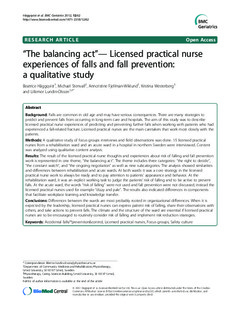| dc.contributor.author | Haggqvist, Beatrice | |
| dc.contributor.author | Stenvall, Michael | |
| dc.contributor.author | Fjellman-Wiklund, Anncristine | |
| dc.contributor.author | Westerberg, Kristina | |
| dc.contributor.author | Lundin-Olsson, Lillemor | |
| dc.date.accessioned | 2017-06-07T12:40:02Z | |
| dc.date.available | 2017-06-07T12:40:02Z | |
| dc.date.issued | 2014 | |
| dc.identifier.citation | Haggqvist, B., Stenvall, M., Fjellman-Wiklund, A., Westerberg, K. & Lundin-Olsson, L. (2014) "The balancing act" - licensed practical nurse experiences of falls and fall prevention: a qualitative study. BMC Geriatrics, Oct 15, 2012, 12(62). | |
| dc.identifier.uri | http://hdl.handle.net/11250/2445117 | |
| dc.description | Artikkelen rapporterer en studie hvor hensikten var å beskrive hjelpepleiere (licensed practical nurses) sine erfaringer med å forutsi og forhindre ytterligere fall når man jobber med pasienter som hadde opplevd et fallrelatert brudd. | |
| dc.description.abstract | Background: falls are common in old age and may have serious consequences. There are many strategies to predict and prevent falls from occurring in long-term care and hospitals. The aim of this study was to describe licensed practical nurse experiences of predicting and preventing further falls when working with patients who had experienced a fall-related fracture. Licensed practical nurses are the main caretakers that work most closely with the patients. Methods: a qualitative study of focus groups interviews and field observations was done. 15 licensed practical nurses from a rehabilitation ward and an acute ward in a hospital in northern Sweden were interviewed. Content was analysed using qualitative content analysis. Results: the result of the licensed practical nurse thoughts and experiences about risk of falling and fall prevention work is represented in one theme, "the balancing act". The theme includes three categories: "the right to decide", "the constant watch", and "the ongoing negotiation" as well as nine subcategories. The analysis showed similarities and differences between rehabilitation and acute wards. At both wards it was a core strategy in the licensed practical nurse work to always be ready and to pay attention to patients appearance and behavior. At the rehabilitation ward, it was an explicit working task to judge the patients risk of falling and to be active to prevent falls. At the acute ward, the words "risk of falling" were not used and fall prevention were not discussed; instead the licensed practical nurses used for example "dizzy and pale". The results also indicated differences in components that facilitate workplace learning and knowledge transfer. Conclusions: differences between the wards are most probably rooted in organizational differences. When it is expected by the leadership, licensed practical nurses can express patient risk of falling, share their observations with others, and take actions to prevent falls. The climate and the structure of the ward are essential if licensed practical nurses are to be encouraged to routinely consider risk of falling and implement risk reduction strategies. | |
| dc.language.iso | eng | |
| dc.rights | Navngivelse 4.0 Internasjonal | |
| dc.rights.uri | http://creativecommons.org/licenses/by/4.0/deed.no | |
| dc.title | The balancing act - licensed practical nurse experiences of falls and fall prevention: a qualitative study | |
| dc.type | Journal article | |
| dc.rights.holder | Häggqvist et al. | |
| dc.source.volume | 12 | |
| dc.source.journal | BMC Geriatrics | |
| dc.source.issue | 62 | |
| dc.identifier.doi | 10.1186/1471-2318-12-62 | |

